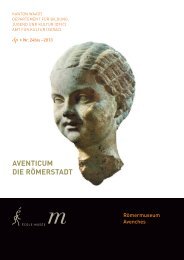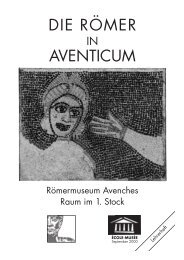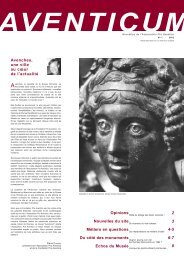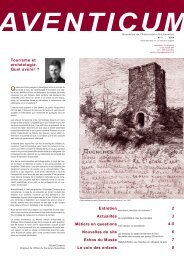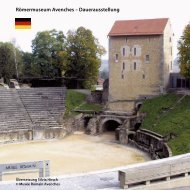Avenches – Roman Museum – Permanent Exhibition
Avenches – Roman Museum – Permanent Exhibition
Avenches – Roman Museum – Permanent Exhibition
Create successful ePaper yourself
Turn your PDF publications into a flip-book with our unique Google optimized e-Paper software.
Ground Floor The Gallo-<strong>Roman</strong> Population of Switzerland and Their View of Death<br />
The Extraordinary Finds at the Necropolis of En Chaplix<br />
deceased has been discovered, but it is possible that the urns containing their ashes<br />
stood on top of the monuments or that these were cenotaphs (empty tombs) and<br />
that the remains were buried elsewhere.<br />
The connection between these two monuments built at an interval of twelve<br />
years is not known. However, it seems plausible that the deceased were related and<br />
perhaps owned the suburban villa situated on the nearby site called Le Russalet.<br />
The villa and the monuments may have belonged to a large native Helvetian family,<br />
thus confirming the rapid integration of the local aristocracy into the new <strong>Roman</strong><br />
order. These two monuments reflected the prosperity of <strong>Avenches</strong> during the<br />
Tiberian period.<br />
The Northern Monument<br />
During the construction of the first monument the unstable ground forced the<br />
builders to set the foundations on a number of oak piles driven deep into the<br />
ground. Thanks to the humidity of the ground the wood was preserved and it was<br />
possible through dendrochronological analyses to establish that the felling dates of<br />
the trees lay between AD 23 and 28.<br />
The sculptures (1) decorating the upper part of the podium on both sides of<br />
the exedra represented two symmetrical groups each consisting of a Triton seizing<br />
a Nereid. The concave part was most probably decorated with friezes as proven by<br />
three rather badly preserved male portraits, one of which was probably part of a<br />
retinue.<br />
Judging by the shape of the roof, the ground plan of the aedicule must have<br />
been octagonal. Only a few fragments of the three statues are preserved. The<br />
central figure was a woman <strong>–</strong> probably the owner and donator of the monument <strong>–</strong><br />
flanked by two men wearing togas.<br />
The crown of the roof was decorated with a group consisting of a Satyr carrying<br />
the Child Bacchus, thus symbolising the elevation of the deceased to higher spheres.<br />
9. Satyr Carrying the Child Bacchus (2)<br />
Satyrs, recognisable by their long horses’ ears and their scruffy hairstyles, belong to the<br />
retinue of the wine god Bacchus. In this instance, Bacchus is depicted as a child and has<br />
wings. This particular feature indicates that he is assimilated with Amor-Somnus who<br />
personifies sleep.<br />
In funerary symbolism groups comprising Satyrs and Bacchus represent the<br />
exhilarating and carefree life in the hereafter. Placing such a group on the roof of the<br />
monument implies that the deceased had achieved a divine existence and was enjoying<br />
life after death. This is very important because it is one of the earliest examples of this<br />
Hellenistic theme having been taken over by the <strong>Roman</strong>s (3rd <strong>–</strong> 2nd centuries BC).<br />
Group, in limestone, crowning the northern monument of En Chaplix. Around 30 AD.<br />
10. Head of a Drunken Silenus (3)<br />
Like the Satyrs, the Sileni belong to the retinue accompanying Bacchus. Their particular<br />
features are horses’ ears, bald heads and bulbous noses. Comparisons with other known<br />
1<br />
2<br />
3<br />
14<br />
Ground Floor



